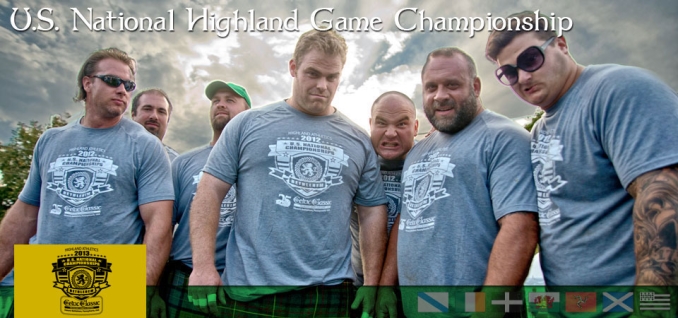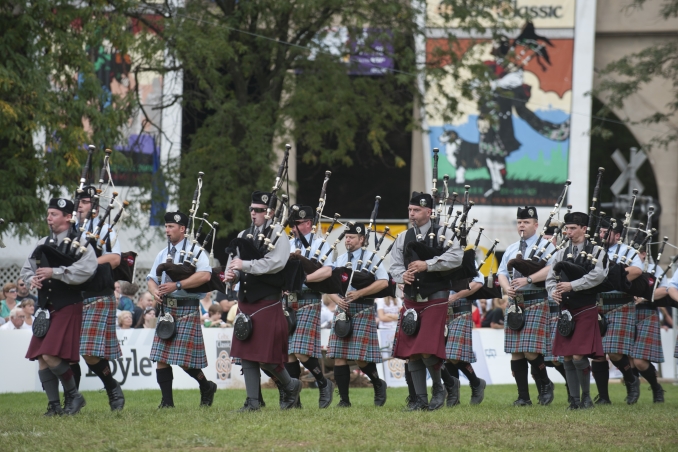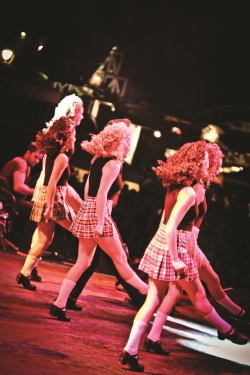The Celtic Festival Renaissance in America – From Milwaukee to Bethlehem

Estimates vary on the number of American’s claiming descent from immigrants to North America from the modern Celtic Nations. More elusive still is identifying the number of American’s descended from Celtic immigrants who enjoy a “Celtic Identity”. An analysis of the American 2010 Census data proffered in an August 2013 article in “Business Insider” estimates the number of descendants of Celtic immigrants to be in the vicinity of 50 million, comprised primarily of Irish, Scottish and Welsh in that order and inclusive of 5 million Americans who claim Scots-Irish ancestry. Manx, Cornish and Breton identity is more difficult to measure as it has generally been subsumed within the census data into either English or French categories.
We at Transceltic believe that the Pan-Celtic movement should look upon Celtic Americans as a reservoir of good will, resources and support as we engage in the struggle to restore Celtic culture and language to its rightful place in the Celtic Nations.
A marker that points to the resurgence of Celtic ethnic identify in America is the growth in attendance at Celtic festivals. It is problematic to gauge how many of the attendees are drawn to these events because they are expressing their Celtic identity versus just showing up because they enjoy a good show. If we assume that 50% of the attendees at Celtic festivals are expressing a Celtic identify, then we are talking about a very large number of people that can be viewed as allies in the Pan Celtic movement and the struggle to preserve the language and culture of the Celtic Nations.

Proof of the Celtic Renaissance in America is the record attendance at the Milwaukee Irish Fest in the American state of Wisconsin and the Celtic Classic Highland Games & Festival, held in the Pennsylvania city of Bethlehem. The combined attendance in 2013 at these two annual events alone approached an astonishing 400,000 revelers. Official estimates are that 250,000 attended the Celtic Classic in Bethlehem and in excess of 125,000 attended the Irish Fest in Milwaukee.
The Milwaukee Irish Fest – Milwaukee, Wisconsin

The success of the Milwaukee Irish Fest since its founding in 1981 has led the National Folk Life Program of the Smithsonian Institute to declare the Milwaukee Irish Fest “the largest and best Irish cultural event in North America.” As the Milwaukee festival has grown in its success the resources gained in this growth has allowed for the establishment of permanent year round educational programs and cultural initiatives. A full-time executive was hired in 1992 and in 1998 the Irish Fest Center was opened. The Center serves as a focal point of “Irish-related activities, including concerts, workshops, rehearsals and Gaelic Language lessons.” In 1992 the Irish Fest established the Ward Irish Music Archives which describes itself as the “largest public collection of Irish Music in America.” In addition, Milwaukee Irish fest Foundation, founded in 1994, has over the years granted over $500,000 to cultural, educational and community based organizations.
The following is a quote from the Press Release announcing the 2013 Irish Fest:
Milwaukee Irish Fest is the world’s largest celebration of Irish music and Culture. The four-day festival showcases more than 100 entertainment acts on 16-stages at Henry W. Mair Festival Park on Milwaukee’s lakefront. The annual festival occurs every third weekend of August.
Patrick Boyle, Executive Director of Milwaukee Irish Fest, stated in the run up to the 2013:
We travel the world in search of the finest Celtic Entertainment. After seeing many phenomenal bands perform in their home towns, we cannot wait to share their talent with our guests.
Mr. Boyle’s commitment to showcase the “finest Celtic Entertainment” was reflected in last year’s Fest which included the “Nova Scotia Showcase” featuring artists from Cape Breton in addition to acts from Ireland and Scotland. The stunning line-up included members of Cape Breton’s fiddling aristocracy, such as Wendy McIsaac, and the hugely successful Celtic Rock band “Gaelic Storm”.

Another aspect of the significance of the Irish Fest contribution to the resurgence of Celtic cultural awareness in North America is the “Summer School” held in Milwaukee in the days running up to the Fest. In 2014 over 25 courses are planned including those in Irish language, instruction in Celtic Design, Dance, and a course in Intermediate Cape Breton Fiddling taught by Wendy MacIsaac who is kin to Natalie Mac Master and member of the Cape Breton Fiddling elite. The Milwaukee Irish Fest Mission statement reads as follows: “To preserve, promote and celebrate all aspects of Irish, Irish American and Celtic cultures and to instill in current and future generations an appreciation of their heritage”.
Celtic Classic Highland Games & Festival – Bethlehem, Pennsylvania

The Celtic Classic Highland Games and Festival was founded in 1988 and is the largest Celtic festival in North America by attendance. The Celtic Classic has seen its attendance grow from 30,000 in 1988 to an average in recent years of 250,000. In 2013 the festival enjoyed the highest level of visitors in the history of the Celtic Classic.
Whereas the Milwaukee festival was founded as an Irish music festival, the Celtic Classic was founded as a Pan Celtic festival drawing from the Scottish, Welsh and Irish immigrant communities of the Bethlehem area of the Lehigh Valley in north eastern Pennsylvania, an area that includes the cities of Allentown and Easton. Jayne Anne Recker, Executive Director of the Celtic Cultural Alliance in Bethlehem and who doubles as Vice President of the Association of Scottish Games and Festivals (US), describes the Celtic Fest as “‘community based’” in that that the event sees the centre of city taken over by the Celtic Classic for three days and admission is free.

The Celtic Fest includes a Highland Dance Competition which is held under the rules of the Scottish Official Board of Highland Dancing (SOBHD), the international governing body of Highland dancing based in Edinburgh. In addition there is a Celtic Classic Youth Fiddle Competition which the festivals’ web page describes as follows: “This is a unique contest focused on Celtic fiddling styles including Irish, Scottish, Cape Breton, Shetland, Orkney and Galician.” On a less serious note, Guinness set up a tent where you can learn to pour a “Perfect Pint” and get a certificate to prove it. Then there is the festival’s Haggis Eating Competition, whiskey tasting events and a Border Collie Exhibition. The 2013 Celtic Fest had an impressive lineup of musical entertainment including Scottish singer Carl Peterson, Canadian Celtic Rock band the Glengarry Bhoys, the Dublin 5 with Irish lead singer Ray Murphy and the Celtic rock band Blackwater.
Two bands returning to the Celtic Classic in 2014 are the Kilmaine Saints and Burning Bridget Cleary. Transceltic contacted members of each band to get their views on their Celtic identity. Burning Bridget Cleary is a Philadelphia area band who’s second CD “Everything Is Alright” was named “2009 Album Of The year” by Boston based CelticRadio.net and who have been nominated by the Irish Music Association this year as “Top Traditional Group in a Pub, Festival, or Concert” . Rose Baldino who plays fiddle, banjo and performs vocals commented:
I’d like to think we are ambassadors of Celtic culture. The band members genuinely love Irish and Celtic music and we are trying to showcase the music to people who maybe aren’t familiar with it.
Michael McNaughton, drummer for the Kilmaine Saints, gave us the following:
As for being ambassadors of Celtic culture, I believe we do see ourselves that way. The music is in our blood when we perform, in our hearts when we write it and in our heads when we sleep. We are out there leading the charge for a younger generation that likes their Celtic music a little harder, a little angrier and a little faster.
The Kilmaine Saints are a band founded in 2009 by members of the Pennsylvania based Lochiel Emerald Society Pipes and Drums along with a classically trained fiddler and a singer from Ireland’s County Mayo. The bands are both successful on the Celtic Festival circuit in North America.

For the sixth consecutive year in 2013, the Celtic Classic was host to the Highland Athletics US National Championship. The top 10 scoring professionals at the end of the competition season qualify to come to the Celtic Classic and compete for the National Championship. There are several invitational World Championships and they are all held prior to the Celtic Classic. Several of the 2013 Celtic Classic qualifiers were ranked top in the world. In addition, the Celtic Classic hosts a Pipe Band competition which awards prizes based on level of competition.
Interview with Patrick Boyle – Executive Director of the Milwaukee Irish Fest
1. The Milwaukee Irish Fest has been called the world’s largest celebration of Irish music and culture with 2013 attendance exceeding 125,000. Can you give us a brief history what you see as contributing to the growing popularity of the Irish Fest?
There are so many things to love about Milwaukee Irish Fest it’s hard to know where to begin. First of all if you’ve never been to Irish Fest you cannot fathom its size, comfort and scope. The event takes place on 75 acres along the beautiful shores of Lake Michigan.

We are unique in a variety of ways. Music is at the heart of the festival and we are constantly searching for new and upcoming talent. We travel throughout the United States and Canada, Ireland, Northern Ireland, Scotland and all over the world in search of talented acts that would be well received in Milwaukee. We have 100 acts on 16 stages covering all types of music from traditional Irish bands to folk and contemporary music to Celtic rock.
Many people also don’t realize that we even have a dedicated Cultural Village on the south end of the grounds. Among many opportunities in this area, guests can learn about their genealogy in the Genealogy area, take in some theatre or dance performances, enjoy shopping more than 90 Irish vendors, learn some Gaelic phrases in the Language area and explore fine authors in the Literary area.
Beyond the major attractions, I think a large part of its contributing popularity is the sense of family. There is truly something here for every one of all ages and children under 12 are always allowed into the festival for free. We are known as a very family-friendly festival and organization. Many families, including my own, have made it an annual event to enjoy Milwaukee Irish Fest together. You don’t have to look hard when attending the Fest to see several generations of families enjoying each other’s company or the multitude of family reunion signs that dot the grounds.
I also attribute the Fest’s success and popularity to its 4,000 plus dedicated volunteers who help keep the festival running smoothly. I don’t know any organization that uses volunteers the way we do and they have formed their own communal family in serving to make Milwaukee Irish Fest the success that it is.
2. The Fest was started 33 years ago as an Irish Festival, in recent years the program has tended to an increasingly Pan Celtic emphasis. For example, last year the Fest highlighted Scottish music from Cape Breton and your Mission Statement makes reference to the promotion of Celtic culture. Do you see a future role at the festival for the Celtic cultures of Scotland, Wales, The Isle of man, Cornwall and Brittany?
Absolutely. Milwaukee Irish Fest strives to celebrate all things Celtic. The Celtic heritage is by no means confined to Ireland. You can find the Celtic heritage and influences spanning much of Europe all the way to Cape Breton in Nova Scotia. The promotion of all things Celtic, whether it is through music, theatre or history has truly taken on a global context. And while our original focus was primarily on Ireland, we now strive to include and incorporate the entire Celtic world in its rich diversity.
3. You have established the Irish Fest Centre, The Irish Fest School of Music and the Ward Irish Music Archives. Can you share with us your vision for these institutions and how they contribute to the Preservation, Promotion of Irish and Celtic culture?
The Milwaukee Irish Fest Center is a fantastic building that serves as our headquarters and houses the Ward Irish Music Archives, School of Music and our administrative offices. We host many different community events in the building as well as year-round programs like a St. Patrick’s Family Day and a variety of different concerts.

The Ward Irish Music Archives was set up to collect, preserve and disseminate our Irish musical heritage. The Archives has done this by taking major historical exhibits on Irish music and film throughout the U.S. via other Irish festivals from New York to California. Programs developed at the Archives have been presented at the Library of Congress, many universities, and other organizations.
Through our websites, the Dunn Family Collection and the Irish Sheet Music Collection, people around the world can listen to music from the early twentieth century and see over 6,000 pieces of Irish-related sheet music. We look to expand our online community through our unique collections and exceptional websites. We want to be known as an international leader in providing this kind of access to people throughout the world, not just people who can personally visit us and see our collections first-hand.
The Irish Fest School of music is growing and we want it to become bigger. It provides an opportunity for people of all ages to learn how to perform Irish and Celtic music that they may not have access to otherwise. Our goal is that the knowledge and talents of our gifted instructors be passed down to younger generations as well as current or new musicians who want to learn a new instrument or style. The school isn’t just for children. We have plenty of adult students. I personally can’t wait to take Celtic guitar lessons.
4. The Irish Fest Chorus has collaborated with the internationally renowned Omagh Youth Choir, who have performed with Andrew Lloyd Weber. Do you see more links between the Irish Fest and organisations and cultural institutions in the Celtic Nations?
Yes, definitely. As we continue to expand our brand and mission more in the Celtic nations our choir has an opportunity to work with organizations and institutions we haven’t been able to before. It is very exciting and we look forward to these new opportunities.
Further information
To find out about Celtic festivals around the world including the USA, visit our Celtic festivals page.
- Pan-Celtic
- English
- Log in to post comments






